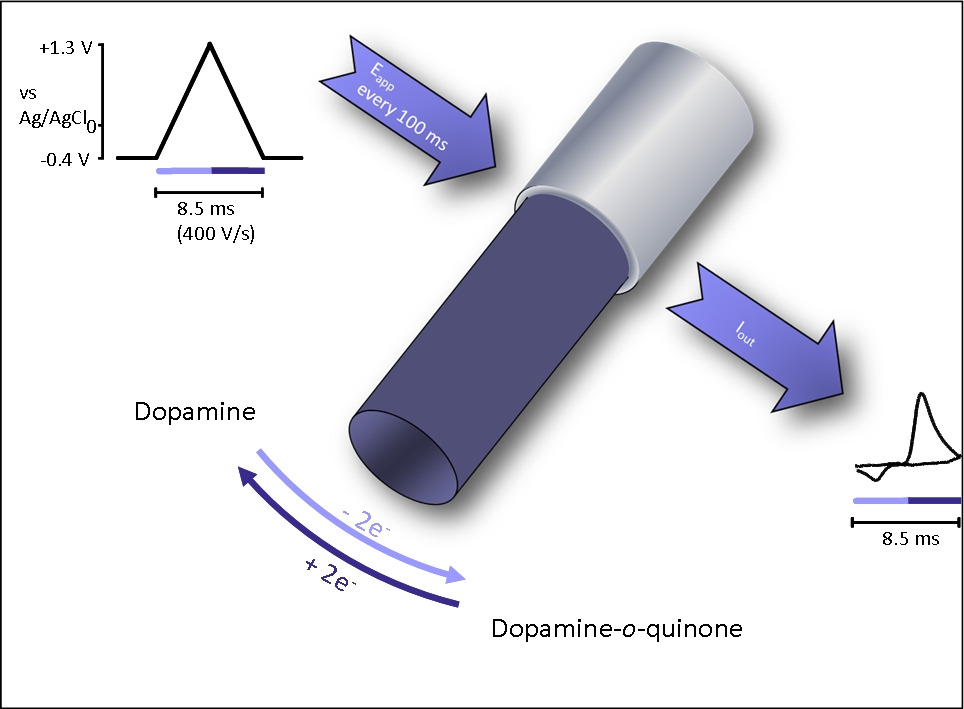The mesolimbic dopamine system has been a primary focus of research related to reward valuation, reinforcement learning, decision making, and pathologies such as addiction. Much attention has been focused upon the subsecond electrophysiological responses of dopamine neurons to behaviorally relevant stimuli including primary rewards, drug rewards, and reward-predicting cues. In our lab we utilize a chronically implanted microsensor
dopamine system has been a primary focus of research related to reward valuation, reinforcement learning, decision making, and pathologies such as addiction. Much attention has been focused upon the subsecond electrophysiological responses of dopamine neurons to behaviorally relevant stimuli including primary rewards, drug rewards, and reward-predicting cues. In our lab we utilize a chronically implanted microsensor coupled with fast-scan cyclic voltammetry
coupled with fast-scan cyclic voltammetry for real-time measurement of dopamine release in behaving animals. Using this approach, behaviorally evoked dopamine dynamics can be recorded with sub-second temporal resolution from day to day over a period of weeks to months.
for real-time measurement of dopamine release in behaving animals. Using this approach, behaviorally evoked dopamine dynamics can be recorded with sub-second temporal resolution from day to day over a period of weeks to months.
Modeling drug use in adolescents
One of the challenges in addressing the consequences of adolescent drug use on adult behavior is the separation of early drug use as a marker of underlying conditions that lead to drug use in adulthood from the long-term effects of drug use itself. Animal models provide a powerful tool; however, developing rodent models of alcohol abuse has been challenged by the fact that most rat strains do not freely consume significant amounts of ethanol. We utilize a palatable gel matrix containing ethanol which, when made available to rats, stimulates robust and reliable self-administration, without the need for fluid or food deprivation. Intake results in significant elevations of blood alcohol concentrations and dose-dependently increases alcohol levels in the brain. Since this delivery method does not require training to promote intake it is particularly suitable for developmental studies, such as those focused on adolescence, since, in rodents, this period is relatively brief.
matrix containing ethanol which, when made available to rats, stimulates robust and reliable self-administration, without the need for fluid or food deprivation. Intake results in significant elevations of blood alcohol concentrations and dose-dependently increases alcohol levels in the brain. Since this delivery method does not require training to promote intake it is particularly suitable for developmental studies, such as those focused on adolescence, since, in rodents, this period is relatively brief.
Reinforcement learning and decision making
Work in our laboratory demonstrates that ingestion of high levels of alcohol by adolescent rats significantly impairs their performance on a decision-making task when they are adults. This impairment results in a suboptimal preference for risky options on a probability-discounting task that may be attributable to a selective imbalance in reinforcement learning
task that may be attributable to a selective imbalance in reinforcement learning . The encoding and updating of the relative value of choices and the cost-benefit computations necessary for adaptive decision making is proposed to be mediated by the mesolimbic dopamine system, a system demonstrated to be altered by chronic alcohol exposure during development. Indeed, we have shown that a history of adolescent alcohol intake promotes increased cue-evoked phasic dopamine transmission in response to cues signaling risky choices. Thus, the central hypothesis of our work is that adolescence alcohol use permanently alters decision making through modulation of dopamine systems.
. The encoding and updating of the relative value of choices and the cost-benefit computations necessary for adaptive decision making is proposed to be mediated by the mesolimbic dopamine system, a system demonstrated to be altered by chronic alcohol exposure during development. Indeed, we have shown that a history of adolescent alcohol intake promotes increased cue-evoked phasic dopamine transmission in response to cues signaling risky choices. Thus, the central hypothesis of our work is that adolescence alcohol use permanently alters decision making through modulation of dopamine systems.
